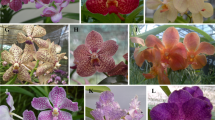Abstract
Brassica oleracea accessions possess traits that would be useful in commercial Brassica crops. These traits can be studied more effectively through the production of doubled haploid plants. Nineteen B. oleracea accessions from several subspecies possessing significant sn-2 erucic acid were screened for suitability for microspore culture using techniques well established for Brassica. Fifteen of the 19 accessions produced embryos. Genotypic differences were observed with embryogenesis ranging from 0 to 3000 embryos/100 buds. Embryogenesis was improved for two of four accessions by initiating cultures in NLN medium with 17% sucrose, then reducing sucrose to 10% after 48 h. An increase in embryogenesis for the same two accessions was observed when microspores were cultured at a density of 100 000/ml rather than 50 000 microspores/ml. A culture temperature of 32 °C for 48 h was beneficial for three of the four accessions when compared to a longer incubation period (72 h) or a higher temperature (35 °C). One accession line, Bo-1, was found to produce microspore-derived embryos which contained triacylglycerols with significant proportions of erucic acid at the sn-2 position.
Similar content being viewed by others
References
Arnison PG, Donaldson P, Ho LCC & Keller WA (1990) The influence of various physical parameters on anther culture of broccoli (Brassica oleracea var. italica). Plant Cell Tiss. Org. Cult. 20: 147–155
Baillie AMR, Epp DJ, Keller WA & Hutcheson D (1992) In vitro culture of isolated microspores and regeneration of plants in Brassica campestris. Plant Cell Rep. 11: 234–237
Bate N, Spurr C, Foster GD & Twell D (1996) Maturation-specific translational enhancement mediated by the 50-UTR of a late pollen transcript. Plant J. 10: 613–623
Cao MQ, Charlot F & Doré C (1990) Embryogenesis and plant regeneration of sauerkraut cabbage (Brassica oleracea L. ssp. capitata) via in vitro isolated microspore culture. C.R. Acad. Sci. Paris 310: 203–209
Curie C & MacCormick S (1997) A strong inhibitor of gene expression in the 50 untranslated region of the pollen-specific LAT59 gene of tomato. Plant Cell 9: 2025–2036
Duijs JG, Voorrips RE, Visser DL & Custers JBM (1992) Microspore culture is successful in most crop types of Brassica oleracea L. Euphytica 60: 45–55
Dunwell JM & Thurling N (1985) Role of sucrose in microspore embryo production in Brassica napus ssp. oleifera. J. Exp. Bot. 36: 1478–1491
Gamborg OL, Miller RA & Ojima K (1968) Nutrient requirements of suspension cultures of soybean root cells. Exp. Cell Res. 50: 151–158
Keller WA & Armstrong KC (1983) Production of haploids via anther culture in Brassica oleracea var. italica. Euphytica 32: 151–169
Keller WA, Arnison PG & Cardy BJ (1987) Haploids from gametophytic cells-recent developments and future prospects. In: Green CE, Somers DA, Hackett WP & Giesboer DD (eds) Plant Tissue and Cell Culture (pp. 223–241). Alan Liss Inc., NY
Lichter R (1982) Induction of haploid plants from isolated pollen of Brassica napus. Z. Pflanzenphysiol. 105: 427–434
MacKenzie SL, Giblin EM, Barton DL, McFerson JR, Tenaschuk D & Taylor DC (1996) Erucic acid distribution in Brassica oleracea seed oil triglycerides. In: Williams JP, Khan MU & Lem NW (eds) Physiology, Biochemistry and Molecular Biology of Plant Lipids (pp. 319–321). Kluwer Academic Publishers, Dordrecht
Ockendon DJ (1984) Anther culture in Brussels sprouts (Brassica oleracea var. gemmifera) I. Embryo yields and plant regeneration. Ann. Appl. Biol. 105: 285–291
Stringam GR, Degenhardt DF, Thiagarajah MR & Bansal VK (1995) Quantum summer rape. Can. J. Plant Sci. 75: 903–904
Swanson EB & Erickson LR (1989) Haploid transformation in Brassica napus using an octopine-producing strain of Agrobacterium tumefaciens. Theor. Appl. Genet. 78: 831–835
Swanson EB, Coumans MP, Brown GL, Patel JD & Beversdorf WD (1988) The characterization of herbicide tolerant plants in Brassica napus L. after in vitro selection of microspores and protoplasts. Plant Cell Rep 7: 83–87
Takahata Y & Keller WA (1991) High frequency embryogenesis and plant regeneration in isolated microspore culture of Brassica oleracea L. Plant Sci. 74: 235–242
Taylor DC, Weber N, Underhill EW, Pomeroy MK, Keller WA, Scowcroft WR, Wilen RW, Moloney MM & Holbrook LA (1990) Storage-protein regulation and lipid accumulation in microspore embryos of Brassica napus L. Planta 181: 18–26
Taylor DC, Magus JR, Bhella R, Zou J-T, MacKenzie SL, Giblin EM, Pass EW & Crosby WL (1992) Biosynthesis of triacylglycerols in Brassica napus L. cv Reston; Target: trierucin. In:MacKenzie SL & Taylor DC (eds) Seed Oils for the Future (pp. 77–102). American Oil Chemists' Society, Champaign, IL
Taylor DC, Ferrie AMR, Keller WA, Giblin EM, Pass EW & MacKenzie SL (1993) Bioassembly of acyl lipids in microsporederived embryos of Brassica campestris L. Plant Cell Rep. 12: 375–384
Taylor DC, MacKenzie SL, McCurdy AR, McVetty PBE, Giblin EM, Pass EW, Stone SJ, Scarth R, Rimmer SR & Pickard MD (1994) Stereospecific analyses of triacylglycerols from high erucic Brassicaceae: detection of erucic acid at the sn-2 position in B. oleracea L genotypes. J. Am. Oil Chem. Soc. 71: 163–167
Taylor DC, Barton DL, Giblin EM, MacKenzie SL, van den Berg CGJ & McVetty PBE (1995) Microsomal Lyso-Phosphatidic Acid Acyltransferase from a Brassica oleracea cultivar incorporates erucic acid into the sn-2 position of seed triacylglycerols. Plant Physiol. 109: 409–420
Ulrich A, Furton WH & Downey RK (1984) Biotechnology and rapeseed breeding: some economic considerations. Sci. Counc. Can. Rep. Ottawa (67p)
Yang Q, Chauvin JE & Herve Y (1992) A study of factors affecting anther culture of cauliflower (Brassica oleracea var. botrytis) Plant Cell Tiss. Org. Cult. 28: 289–296
Author information
Authors and Affiliations
Rights and permissions
About this article
Cite this article
Ferrie, A., Taylor, D., MacKenzie, S. et al. Microspore embryogenesis of high sn-2 erucic acid Brassica oleracea germplasm. Plant Cell, Tissue and Organ Culture 57, 79–84 (1999). https://doi.org/10.1023/A:1006325431653
Issue Date:
DOI: https://doi.org/10.1023/A:1006325431653




